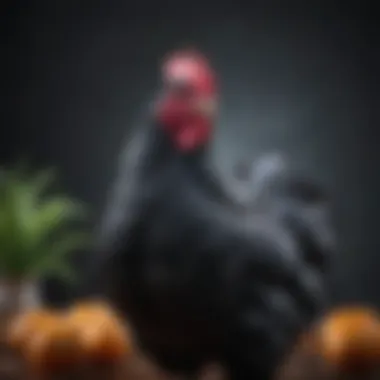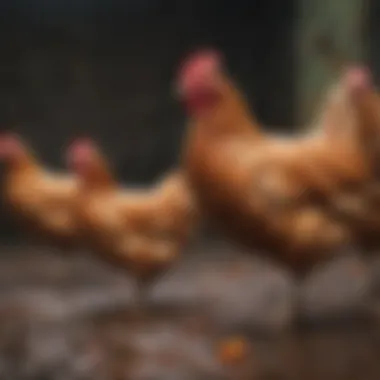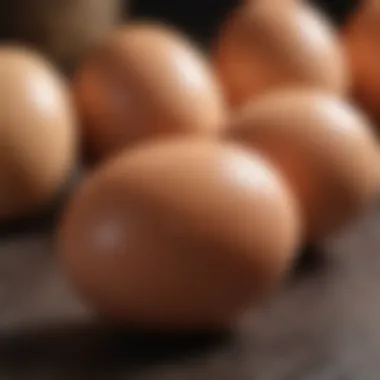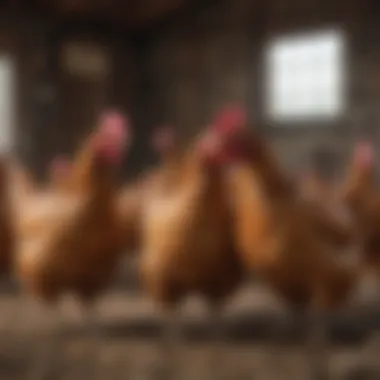Langshan Chicken: Unique Breed Insights and Care


Intro
The Langshan chicken is a breed that has intrigued poultry enthusiasts and farmers alike. Originating from China, its unique qualities make it a subject of fascination. The breed's origin can be traced back to the Langshan region, where it has coexisted with humans for generations, specifically valued for both its meat and ornamental beauty. Its adaptability to a variety of environments sets it apart from other breeds, contributing to its growing popularity. This article aims to provide a comprehensive understanding of the Langshan chicken, focusing on various aspects crucial for poultry caretakers and enthusiasts.
Grooming Techniques
The grooming of Langshan chickens is essential for maintaining their health and appearance. Regular grooming helps with hygiene and can prevent various health issues. It also ensures that the chickens look their best, which is particularly important for those who keep them for aesthetic purposes in shows or exhibitions.
Basic Grooming Tools
To properly groom your Langshan chickens, you will need several basic tools:
- A soft-bristle brush: Perfect for removing dirt and loose feathers.
- Nail clippers: Essential for keeping their claws in check.
- A grooming comb: Helps detangle feathers and removes debris.
- Mild soap solution or poultry shampoo: Useful for deeper cleans without irritating the skin.
- A pair of gloves: Ensures both your safety and the chicken's comfort during grooming.
Step-by-Step Grooming Guides
- Prepare your space: Choose a calm area free from distractions.
- Brush the feathers: Use a soft-bristle brush to gently remove dirt and loose feathers.
- Check the nails: Inspect the nails; if they are too long, carefully trim them using nail clippers.
- Wash if necessary: If your chickens look particularly dirty, wash them with a mild soap solution, ensuring that you avoid getting soap in their eyes.
- Dry thoroughly: After washing, dry them well with a soft towel. It's important that they are not left damp to prevent chills.
Breed-Specific Grooming Needs
The Langshan chicken has unique grooming needs due to its feather structure and body shape. Their feathers can become matted if not cared for properly, so they may require more frequent grooming in damp environments. Attention to the legs and feet is also crucial, as debris can easily accumulate there, leading to irritation or injury.
Health and Wellness
Ensuring the health and wellness of your Langshan chickens is fundamental for their longevity and productivity. Being informed about their nutritional and health needs is essential.
Nutrition and Diet Tips
Feeding Langshan chickens a balanced diet is crucial to their health. Their diet should consist of:
- High-quality poultry feed: A complete feed that meets their requirements.
- Fresh vegetables: Leafy greens and root vegetables can provide essential nutrients.
- Protein sources: Consider adding mealworms or insects for extra protein, especially during the laying period.
- Clean water: Ensure they always have access to clean and fresh water.
Common Health Issues and Solutions
Langshan chickens are typically hardy but may face common problems:
- Mite infestations: Regular checks and treatments with appropriate remedies can prevent these.
- Respiratory infections: Keep the coop well-ventilated and clean to minimize this risk.
- Feather loss: Ensure proper nutrition to maintain feather health.
Importance of Regular Check-Ups
Regular veterinary check-ups help in early detection of potential health issues. Consult a veterinarian familiar with poultry to perform routine assessments of your chickens.
Community Insights
Learning from the experiences of other Langshan chicken owners can significantly enhance your care techniques.
User-Submitted Tips and Tricks
Many owners suggest:


- Keeping a clean coop: Prevents disease and pests.
- Socialization: Spending time with your chickens can help them become more friendly.
Real-Life Grooming Experiences
Participating in online forums like Reddit, you can read firsthand accounts of grooming challenges and successes experienced by other Langshan chicken owners.
Expert Guest Contributions
Consider reading articles contributed by poultry experts. They often share insights on advanced grooming techniques and health management that can elevate your understanding.
Understanding the breed's specific needs improves not only their bienestar but also enhances your experience as a keeper.
Prelims to Langshan Chicken
Langshan Chicken is a breed that finds its roots in ancient China. Understanding its background is crucial for anyone interested in poultry farming. This breed not only fulfills agricultural needs but also enhances the aesthetics of a farm. Langshan chickens are recognized for their high-quality meat and hardy nature, making them a preferred choice for many farmers. They adapt well to different environments, showcasing versatility that is rare in poultry.
Historical Context
The Langshan chicken is believed to have originated from the Langshan region in China during the 19th century. Initially, they were used mainly for meat production, which was essential in rural communities. As their popularity grew, they made their way to Europe and other regions. By the early 1900s, the breed was introduced to poultry exhibitions. This exposure led to a formal recognition of Langshan chickens. Their resilient nature and adaptability reflect a long history shaped by agricultural practices. The genetic lineage of Langshan chickens offers a glimpse into historical breeding methods, showcasing how selective breeding can impact a breed’s characteristics over time.
Cultural Significance
Langshan chickens hold a notable place in Chinese culture. They represent not just a source of food but also a symbol of community and agricultural heritage. These birds were often featured in local festivals. Their unique appearance and behavior made them a point of pride for many farmers. Today, the appreciation for the Langshan breed continues in various forms. Organic and sustainable farming movements often promote this breed as a way to preserve traditional practices. Moreover, as biodiversity becomes a pressing concern, the cultivation of diverse breeds like the Langshan provides essential support in maintaining genetic diversity within poultry. Hence, they are increasingly recognized as vital to both local agriculture and global conservation efforts.
Physical Characteristics
Understanding the physical characteristics of Langshan chicken is crucial for several reasons. These traits impact their adaptability to different environments, their usefulness in farms, and their appeal to poultry enthusiasts. By examining size, weight, feathering, color patterns, and comb types, we gain insights into what makes this breed unique. Knowledge of these characteristics helps potential owners make informed decisions when incorporating Langshan chickens into their flocks.
Size and Weight
Langshan chickens are considered medium to large-sized birds. Generally, the cocks can weigh between 7 to 9 pounds, while hens usually weigh around 5 to 7 pounds. This size makes them suitable for both meat production and egg laying. The robust body structure and weight of the Langshan chicken contribute to its overall hardiness. This characteristic enhances adaptability in diverse climates and conditions.
Furthermore, their size plays a role in how they fare against predators. Larger birds have a better chance of deterring potential threats. Owners must keep in mind the size of their housing and living space to ensure these birds have enough room to thrive. Thus, evaluating size and weight is necessary for proper care and management.
Feathering and Color Patterns
Langshan chickens are well-known for their distinctive feathering and color patterns. The most common coloration is black, but they can also appear in other shades like blue and white. Their feathering is quite unique; it is soft and beautifully arranged, creating a visually appealing bird. The quality of the feathers can reflect overall health, affecting their insulation and protection against weather.
The look of Langshan chickens makes them attractive not just for poultry producers but also for individuals who appreciate ornamental birds. Understanding the varieties and characteristics of feather patterns can help in breeding decisions. Their feathers also influence their ability to cope in different environments, so this aspect must not be overlooked by prospective owners.
Comb Types and Features
Langshan chickens have a unique type of comb known as a single comb. This feature is not only aesthetic but functional. The single comb is upright and tends to be larger than those found on other breeds. It helps with regulating body temperature, which is essential for the bird's health. A proper comb can indicate the overall vitality of a chicken, making it an essential factor in assessment.
The size and health of the comb can also impact breeding choices. Breeders often consider comb characteristics when aiming for particular traits in offspring. Keeping in mind the combs can also help owners identify issues related to health or stress. Therefore, it is important to monitor this feature as part of regular health checks.
The physical characteristics of Langshan chicken are not just for show; they play vital roles in health, adaptability, and breeding.
Temperament and Behavior
Understanding the temperament and behavior of Langshan chickens is essential for anyone considering this breed for their farm or backyard. These characteristics dictate how they interact with their environment and their overall suitability for various farming practices. An appreciation of their nature not only ensures better management but fosters a more enriching relationship between the owner and the flock.


General Disposition
Langshan chickens are known for their calm and docile nature. This breed tends to be friendly and tolerates handling, making them suitable for families and hobbyists. Their sociable temperament allows them to coexist well with humans and other animals. However, it is paramount to note that their gentle disposition can vary based on individual personalities and their rearing conditions.
These birds are generally active but not overly aggressive. They exhibit a curious behavior, often exploring their surroundings, which is vital for their mental stimulation. When kept in larger flocks, Langshans can show a hierarchy, but this is usually gentle and not hostile. Owners should be aware that a stress-free environment contributes significantly to their well-being. Thus, ensuring enough space and enriching activities can enhance their quality of life.
Social Interactions with Other Breeds
Langshan chickens typically display compatibility with various other poultry breeds. Their placid demeanor allows them to integrate into a mixed flock without significant issues. However, it is advisable to introduce them to new birds gradually to minimize any initial stress or territorial behavior.
When mixed with more dominant breeds, Langshans might take a step back. Owners need to monitor interactions closely, ensuring smaller or less assertive breeds do not get bullied. Establishing a balanced environment with plenty of resources like food, water, and shelters is beneficial for maintaining harmony in a mixed flock.
In summary, the temperament of Langshan chickens is generally favorable for both novice and experienced poultry owners. Their calm nature and sociability can significantly contribute to a peaceful and productive poultry environment.
Reproductive Traits
Reproductive traits are critical when assessing the Langshan chicken breed. Understanding these traits helps both novice and seasoned chicken keepers optimize breeding practices. Effective management of the reproductive characteristics can significantly impact the viability, productivity, and overall health of the flock. This section focuses on two main aspects: egg production and broodiness, which together contribute to the breed's success in modern poultry farming.
Egg Production
Egg production is a vital aspect of the Langshan chicken's reproductive traits. This breed is known to produce a moderate number of eggs, typically around 150 to 200 eggs per year. The eggs laid tend to be medium-sized with a light brown color. While turkey and duck breeds may produce more eggs, the Langshan chicken is appreciated for the quality of its eggs. The consumption of Langshan eggs is popular among culinary enthusiasts who favor rich, flavorful eggs.
Several factors influence egg production in Langshan chickens:
- Age of the hen: Younger hens start laying eggs earlier and may produce more during their first year.
- Nutrition: A balanced diet that includes protein, calcium, and other vital nutrients supports egg production.
- Environmental conditions: Light exposure, housing temperature, and stress levels can all affect a hen's laying patterns.
By ensuring these elements are in check, poultry owners can maximize egg yield and ensure the long-term viability of their Langshan flock.
Broodiness and Parenting Behavior
Broodiness is another critical reproductive trait of the Langshan chicken. This term refers to the instinct of hens to sit on their eggs to incubate them until they hatch. Langshan hens have a notable tendency to go broody, which can be advantageous for those raising chicks naturally. A broody hen would typically brood around 10 to 15 eggs, providing dedicated care throughout the incubation period, lasting about 21 days.
The parenting behavior of Langshan chickens is commendable as well. Mother hens are generally attentive and protective. They nurture their chicks by keeping them warm and safe from potential threats. In this way, Langshan chickens contribute to the survival and growth of their progeny.
Nutritional Requirements
Understanding the nutritional requirements of Langshan chickens is essential for their overall health and productivity. These birds, like all breeds of poultry, have specific dietary needs that must be met to ensure optimal growth, egg production, and disease resistance. Proper nutrition not only contributes to the well-being of individual chickens but also affects the entire flock's performance. A balanced diet provides essential nutrients, supports metabolic processes, and enhances the immune system, which is crucial for preventing potential health problems.
Balanced Diet for Optimal Health
A balanced diet for Langshan chickens should include a variety of components. The primary ingredients usually consist of grains, protein sources, vitamins, and minerals. Here are key elements to consider:
- Grains: Corn, wheat, and barley serve as excellent energy sources.
- Protein: This is vital for growth and egg-laying. Sources can include soybean meal, fish meal, and insects.
- Vitamins and Minerals: These are crucial for metabolic functions. Include vitamin A, D3, E, calcium, and phosphorus.
- Water: Clean, fresh water must always be available to help with digestion and regulating body temperature.
Meeting these nutritional needs helps to promote good health and productivity in Langshan chickens, ensuring they thrive in the best conditions.
Supplemental Nutrition
In addition to a balanced diet, Langshan chickens may benefit from supplemental nutrition. This can help fill gaps in their diet and support their health. Here are some common supplements:


- Electrolytes: Helpful during heat stress or illness.
- Probiotics: Help to maintain a healthy gut flora.
- Mineral Blocks: Provide essential minerals and trace elements.
- Greens: Leafy vegetables can offer vitamins and improve palatability.
Adding supplements should be approached with caution. Always consult a vet or poultry nutritionist if unsure about specific needs.
Proper nutrition is the foundation of successful poultry management.
Balancing the dietary components effectively will support the unique needs of Langshan chickens while enhancing their health and productivity.
Care and Management
Caring for Langshan chickens is critical for their well-being and productivity. This breed thrives under the right conditions and with appropriate management practices. Understanding the specific needs of Langshan chickens ensures they remain healthy and continue to produce quality eggs and meat. Proper care includes providing suitable housing, regular health checks, and an adequate diet, all of which contribute to their longevity and productivity.
Housing Needs
Langshan chickens require a secure and comfortable environment to flourish. The design of the housing affects their health and behavior significantly. Suitable housing should provide protection from harsh weather, predators, and other stressors. Here are key considerations for housing:
- Space: Each bird needs sufficient room to move around, ideally at least 4 square feet per chicken in the coop and 10 square feet in the run.
- Ventilation: Good airflow is necessary to prevent respiratory problems. Ensure windows can be opened and there are vents near the roof of the coop.
- Bedding: Use straw or wood shavings for bedding. This helps absorb waste and maintain hygiene. Change it regularly to avoid ammonia buildup.
- Nesting Boxes: Provide boxes where hens can lay eggs. One box for every 3-4 hens is typically sufficient. Ensure these are located in a quiet and dimmed area of the coop.
By considering these elements, Langshan chickens will feel at home, leading to happier and healthier birds.
Health Monitoring
Regular health monitoring is essential in maintaining the health of Langshan chickens. Early detection of any issues can save lives and assure continued productivity. Here's how to approach health monitoring:
- Visual Inspections: Daily checks for signs of illness or distress. Look for abnormal behavior, ruffled feathers, or changes in appetite.
- Vaccinations: Keeping up with vaccinations can prevent many diseases. Work with a veterinarian to ensure all necessary vaccinations are administered.
- Weight Tracking: Monitor weight periodically. Weight loss can signal health problems.
- Parasite Control: Regular checks for external parasites. Consult with a vet about an appropriate deworming schedule and methods to manage pests.
Langshan Chicken in Modern Farming
Langshan chicken has adapted well to the modern agricultural landscape. Understanding its significance in current farming practices is essential for both beginners and seasoned poultry keepers. This breed's unique qualities can greatly benefit farming efficiency and sustainability.
Sustainable Farming Practices
Sustainable farming emphasizes methods that maintain ecological balance while providing food and resources. Langshan chickens contribute positively to these practices. They are hardy and resilient birds, capable of thriving in diverse environments. This adaptability reduces reliance on chemical inputs and enhances soil health through their natural foraging behaviors. By grazing and pecking at insects, they naturally control pests, minimizing the need for pesticides.
Moreover, their capacity to produce high-quality meat and eggs establishes them as an economical choice for farmers looking for financial sustainability. The integration of Langshan chickens into existing farm operations can lead to better waste management as they can consume food scraps and leftovers, turning potential waste into nutrient-rich manure.
Additionally, raising this breed encourages polyculture. By combining them with other animals or crops, farmers can create a balanced ecosystem. This practice promotes biodiversity on the farm, establishing a network where different species support each other's growth and health.
Contribution to Biodiversity
Langshan chickens are more than just a source of food; they are integral to maintaining biodiversity within agricultural systems. This breed possesses genetic traits that enhance their resilience to diseases and harsh climates. Such characteristics are crucial as they help in adapting to changes in environmental conditions caused by climate change.
The preservation of various chicken breeds, including the Langshan, aids in the conservation of genetic diversity among livestock. A rich genetic pool allows farmers to select birds that best fit their farming goals and local conditions, which may help boost local food security.
The Langshan chicken plays a vital role in sustainable agriculture, helping farmers maintain ecological balance while promoting food security.
Culmination
The conclusion of this article on Langshan Chicken encapsulates its significance not only as a distinctive poultry breed but also as a vital contributor to sustainable agriculture. Its unique traits, including adaptability and resilience, make it an invaluable addition to any poultry collection. The breed has also shown its ability to thrive in diverse environments, and these characteristics make it an attractive choice for both traditional and modern farming methods.
Future of the Langshan Chicken
As we look ahead, the future of the Langshan chicken seems promising. Many factors contribute to this optimism:
- Increased Awareness: There is a growing interest in heritage breeds. More poultry enthusiasts and farmers are recognizing the importance of preserving genetic diversity, and the Langshan chicken fits this need perfectly.
- Sustainable Farming Practices: As concerns around sustainability grow, the Langshan chicken stands out due to its lower feed-to-meat conversion ratio. Its hardiness allows it to thrive with fewer resources compared to more commercial breeds.
- Potential in Niche Markets: The unique flavor and quality of Langshan chicken meat can captivate gourmet markets. As ethical farming continues to gain traction, dishes featuring this breed may become sought after.
- Community Support and Promotion: Organizations and forums around the world, such as those found on platforms like Reddit and Facebook, facilitate discussions about raising and breeding this chicken. This community generates valuable insights on care and management, which helps both new and seasoned owners.
"Heritage breeds like the Langshan chicken are crucial for the sustainability of our agricultural systems."







